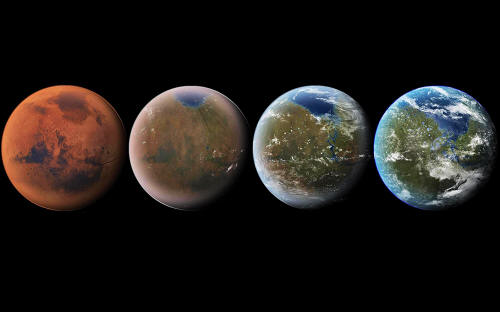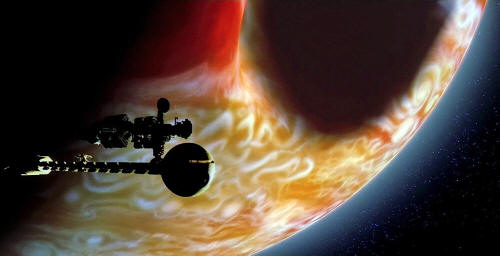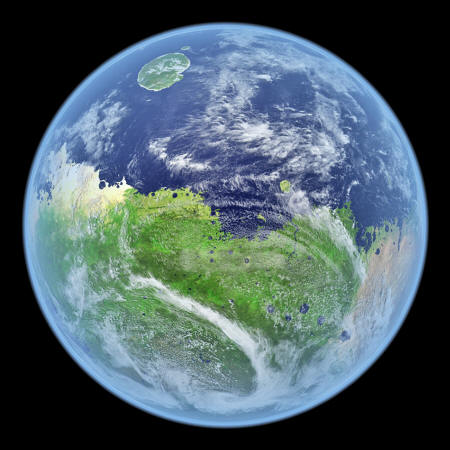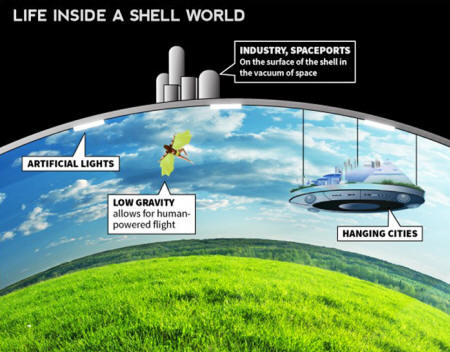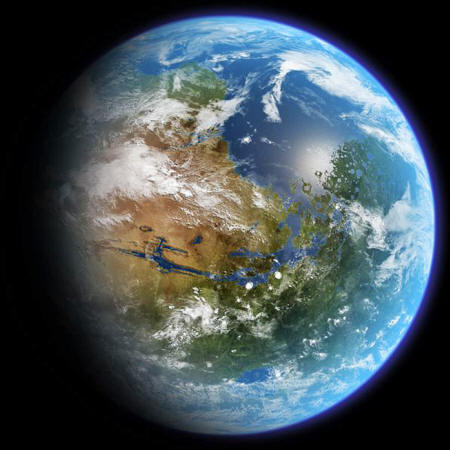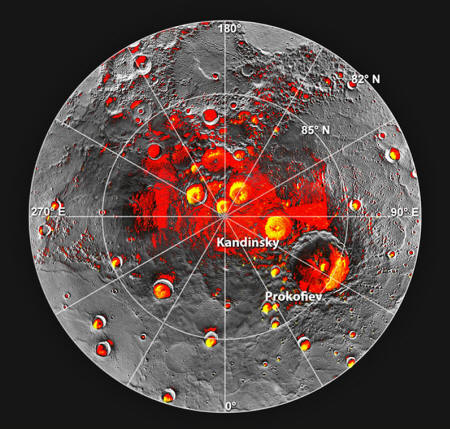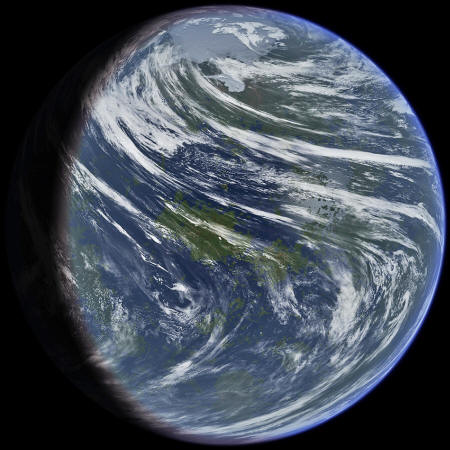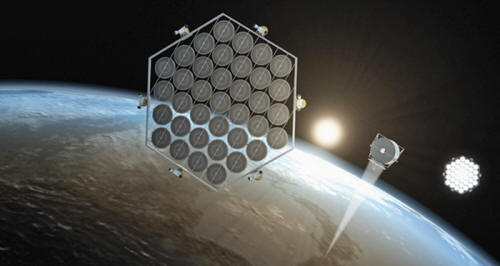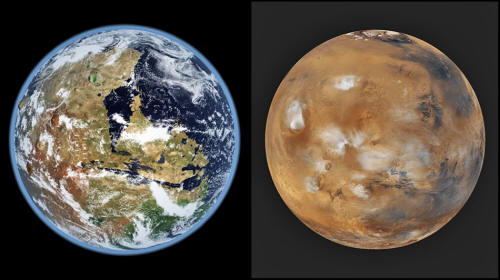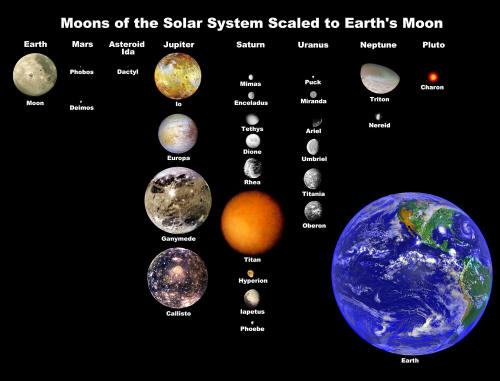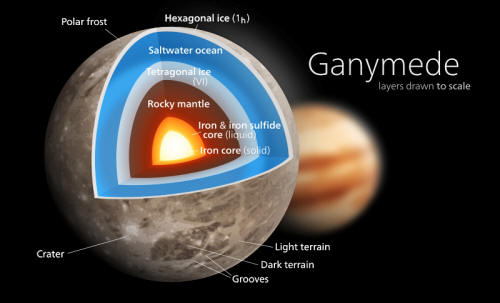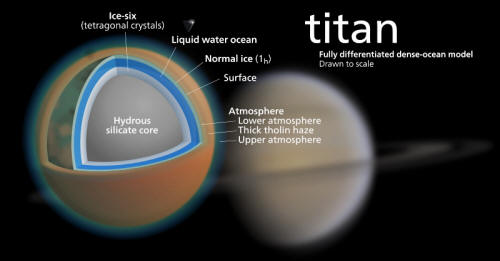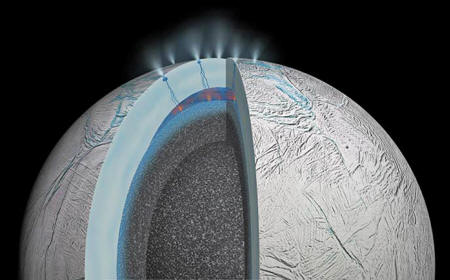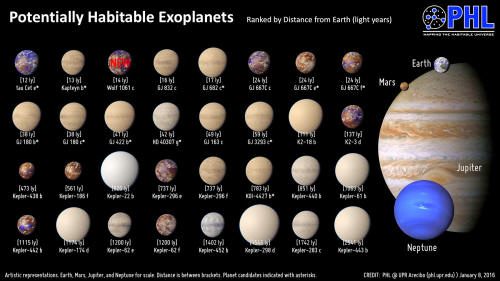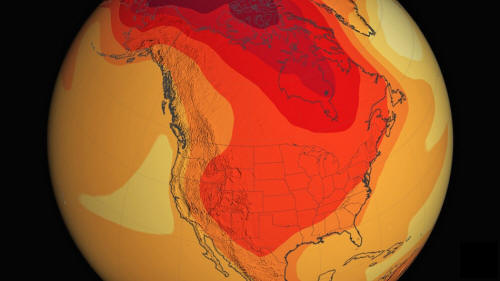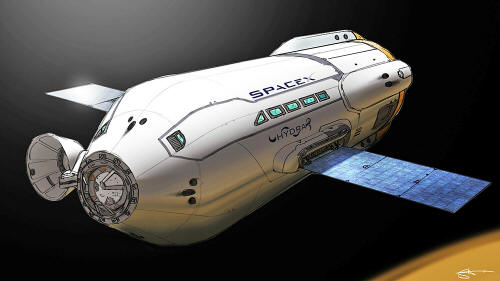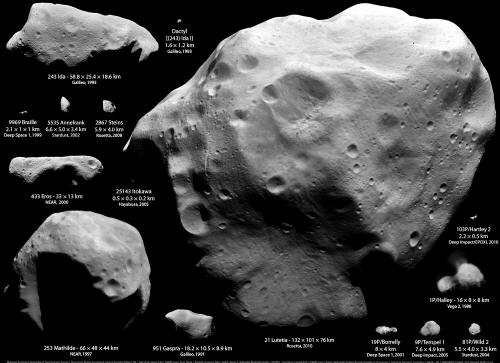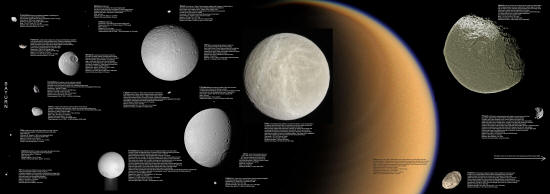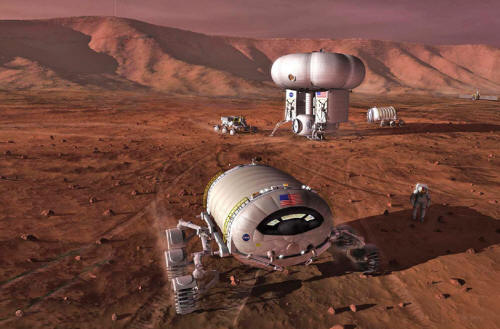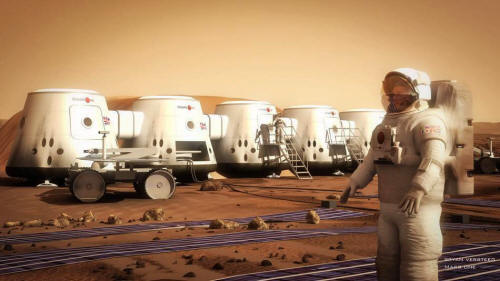|
from
UniverseToday Website
Artist's impression of the terraforming of Mars, from its current state to a livable world. Credit: Daein Ballard
However, in recent years, thanks to renewed interest in space exploration, this word is being used in an increasingly serious manner. And rather than being talked about like a far-off prospect, the issue of terraforming other worlds is being addressed as a near-future possibility.
Whether it's Elon Musk claiming that humanity needs a "backup location" in order to survive, private ventures like MarsOne looking to send humans on a one-way mission to colonize the Red Planet, or space agencies like NASA and the ESA discussing the prospect of long-term habitability on Mars or the Moon, terraforming is yet another science fiction concept that appears to be moving towards science fact.
But just,
Answering any or all of these questions requires that we do a bit of digging.
Not only is terraforming a time-honored concept, but as it turns out, humanity already has quite a bit of experience in this area!
Origin Of The Term
To break it down, terraforming is the process whereby a hostile environment (i.e. a planet that is too cold, too hot, and/or has an unbreathable atmosphere) is altered in order to be suitable for human life.
This could involve modifying the temperature, atmosphere, surface topography, ecology - or all of the above - in order to make a planet or moon more "Earth-like".
Venus is considered by many to be a prime candidate for terraforming. Credit: NASA/JPL/io9.com
The term was coined by Jack Williamson, an American science fiction writer who has also been called "the Dean of science fiction" (after the death of Robert Heinlein in 1988).
The term appeared as part of a science-fiction story titled "Collision Orbit", which was published in the 1942 editions of the magazine Astounding Science Fiction. This is the first known mention of the concept, though there are examples of it appearing in fiction beforehand.
Terraforming in Fiction
Science fiction is filled with examples of altering planetary environments to be more suitable to human life, many of which predate the scientific studies by many decades.
For example, in H.G. Wells' War of the Worlds, he mentions at one point how the Martian invaders begin transforming Earth's ecology for the sake of long-term habitation.
In Olaf Stapleton's Last And First Men (1930), two chapter are dedicated to describing how humanity's descendants terraform Venus after Earth becomes uninhabitable; and in the process, commit genocide against the native aquatic life.
By the 1950s and 60s, owing to the beginning of the Space Age, terraforming began to appear in works of science fiction with increasing frequency.
One such example is Farmer in the Sky (1950) by Robert A. Heinlein. In this novel, Heinlein offers a vision of Jupiter's moon Ganymede, which is being transformed into an agricultural settlement.
This was a very significant work, in that it was the first where the concept of terraforming is presented as a serious and scientific matter, rather than the subject of mere fantasy.
Scene from 2010: The Year We Make Contact, the movie adaptation of Clarke's novel. Credit: Metro-Goldwyn-Mayer
In 1951, Arthur C. Clarke wrote the first novel in which the terraforming of Mars was presented in fiction.
Titled The Sands of Mars, the story involves Martian settlers heating up the planet by converting Mars' moon Phobos into a second sun, and growing plants that break down the Martians sands in order to release oxygen.
In his seminal book 2001 - A Space Odyssey - and it's sequel, 2010 - Odyssey Two - Clarke presents a race of ancient beings ("Firstborn") turning Jupiter into a second sun so that Europa will become a life-bearing planet.
Poul Anderson also wrote extensively about terraforming in the 1950s.
In his 1954 novel, The Big Rain, Venus is altered through planetary engineering techniques over a very long period of time. The book was so influential that the term term "Big Rain" has since come to be synonymous with the terraforming of Venus.
This was followed in 1958 by the Snows of Ganymede, where the Jovian moon's ecology is made habitable through a similar process.
In Issac Asimov's Robot series, colonization and terraforming is performed by a powerful race of humans known as "Spacers", who conduct this process on fifty planets in the known universe. In his Foundation series, humanity has effectively colonized every habitable planet in the galaxy and terraformed them to become part of the Galactic Empire.
In 1984, James Lovelock and Michael Allaby wrote what is considered by many to be one of the most influential books on terraforming. Titled The Greening of Mars, the novel explores the formation and evolution of planets, the origin of life, and Earth's biosphere.
The terraforming models presented in the book actually foreshadowed future debates regarding the goals of terraforming.
Kim Stanley Robinson's Red Mars Trilogy. Credit: variety.com
In the 1990s, Kim Stanley Robinson released his famous trilogy that deals with the terraforming of Mars.
Known as the Mars Trilogy - Red Mars, Green Mars, Blue Mars - this series centers on the transformation of Mars over the course of many generations into a thriving human civilization. This was followed up in 2012 with the release of 2312, which deals with the colonization of the Solar System - including the terraforming of Venus and other planets.
Countless other examples can be found in popular culture, ranging from television and print to films and video games.
Study Of Terraforming
In an article published by the journal Science in 1961 (Planet Venus - Recent Observations Shed Light on Atmosphere, Surface, and possible Biology of Nearest Planet), famed astronomer Carl Sagan proposed using planetary engineering techniques to transform Venus.
This involved seeding the atmosphere of Venus with algae, which would convert the atmosphere's ample supplies of water, nitrogen and carbon dioxide into organic compounds and reduce Venus' runaway greenhouse effect.
In 1973, he published an article in the journal Icarus titled "Planetary Engineering on Mars", where he proposed two scenarios for transforming Mars.
These included transporting low albedo material and/or planting dark plants on the polar ice caps to ensure it absorbed more heat, melted, and converted the planet to more "Earth-like conditions".
In 1976, NASA addressed the issue of planetary engineering officially in a study titled "On the Habitability of Mars - An Approach to Planetary Ecosynthesis".
The study concluded that photosynthetic organisms, the melting of the polar ice caps, and the introduction of greenhouse gases could all be used to create a warmer, oxygen and ozone-rich atmosphere.
The first conference session on terraforming, then referred to as "Planetary Modeling", was organized that same year.
Artist concept of a ‘Living' Mars. Credit: Kevin Gill
And then in March of 1979, NASA engineer and author James Oberg organized the First Terraforming Colloquium - a special session at the Tenth Lunar and Planetary Science Conference, which is held annually in Houston, Texas.
In 1981, Oberg popularized the concepts that were discussed at the colloquium in his book New Earths: Restructuring Earth and Other Planets.
In 1982, Planetologist Christopher McKay wrote "Terraforming Mars", a paper for the Journal of the British Interplanetary Society. In it, McKay discussed the prospects of a self-regulating Martian biosphere, which included both the required methods for doing so and ethics of it.
This was the first time that the word terraforming was used in the title of a published article, and would henceforth become the preferred term.
This was followed by James Lovelock and Michael Allaby's The Greening of Mars in 1984. This book was one of the first to describe a novel method of warming Mars, where chlorofluorocarbons (CFCs) are added to the atmosphere in order to trigger global warming.
This book motivated biophysicist Robert Haynes to begin promoting terraforming as part of a larger concept known as Ecopoiesis.
Derived from the Greek words oikos ("house") and poiesis ("production"), this word refers to the origin of an ecosystem. In the context of space exploration, it involves a form of planetary engineering where a sustainable ecosystem is fabricated from an otherwise sterile planet. As described by Haynes, this begins with the seeding of a planet with microbial life, which leads to conditions approaching that of a primordial Earth.
This is then followed by the importation of plant life, which accelerates the production of oxygen, and culminates in the introduction of animal life.
An engineer suggests building a roof over a small planet so that Earthlike conditions could be maintained. Credit: Karl Tate/space.com
In 2009, Kenneth Roy - an engineer with the US Department of Energy - presented his concept for a "Shell World" in a paper published with the Journal of British Interplanetary Sciences.
Titled "Shell Worlds - An Approach to Terraforming Moons, Small Planets and Plutoids", his paper explored the possibility of using a large "shell" to encase an alien world, keeping its atmosphere contained long enough for long-term changes to take root.
These and other concepts where a world is enclosed (in whole or in part) in an artificial shell in order to transform its environment is also known as "paraterraforming".
Potential Sites
Within the Solar System, several possible locations exist that could be well-suited to terraforming.
Consider the fact that besides Earth, Venus and Mars also lie within the Sun's Habitable Zone (aka. "Goldilocks Zone"). However, owing to Venus' runaway greenhouse effect, and Mars' lack of a magnetosphere, their atmospheres are either too thick and hot, or too thin and cold, to sustain life as we know it.
However, this could theoretically be altered through the right kind of ecological engineering.
Other potential sites in the Solar System include some of the moons that orbit the gas giants. Several Jovian (i.e. in orbit of Jupiter) and Cronian (in orbit of Saturn) moons have an abundance of water ice, and scientists have speculated that if the surface temperatures were increased, viable atmospheres could be created through electrolysis and the introduction of buffer gases.
Artist's conception of a terraformed Mars. Credit: Ittiz/Wikimedia Commons
There is even speculation that Mercury and the Moon (or at least parts thereof) could be terraformed in order to be suitable for human settlement.
In these cases, terraforming would require not only altering the surface, but perhaps also adjusting their rotation. In the end, each case presents its own share of advantages, challenges, and likelihoods for success.
Let's consider them in order of distance from the Sun.
Inner Solar System
The terrestrial planets of our Solar System present the best possibilities for terraforming.
Not only are they located closer to our Sun, and thus in a better position to absorb its energy, but they are also rich in silicates and minerals - which any future colonies will need to grow food and build settlements.
And as already mentioned, two of these planets (Venus and Mars) are located within Earth's habitable zone.
Outer Solar System
Beyond the Inner Solar System, there are several sites that would make for good terraforming targets as well.
Particularly around Jupiter and Saturn, there are several sizable moons - some of which are larger than Mercury - that have an abundance of water in the form of ice (and in some cases, maybe even interior oceans).
The moons of the Solar System, shown to scale. Credit: planetary.org
At the same time, many of these same moons contain other necessary ingredients for functioning ecosystems, such as frozen volatiles - like ammonia and methane.
Because of this, and as part of our ongoing desire to explore farther out into our Solar System, many proposals have been made to seed these moons with bases and research stations.
Some plans even include possible terraforming to make them suitable for long-term habitation.
Exoplanets
Of the 1,941 confirmed exoplanets discovered so far, these planets are those that have been designated "Earth-like." In other words, they are terrestrial planets that have atmospheres and, like Earth, occupy the region around a star where the average surface temperature allows for liquid water (aka. habitable zone).
The first planet confirmed by Kepler to have an average orbital distance that placed it within its star's habitable zone was Kepler-22b.
This planet is located about 600 light years from Earth in the constellation of Cygnus, was first observed on May 12th, 2009 and then confirmed on Dec 5th, 2011.
Based on all the data obtained, scientists believe that this world is roughly 2.4 times the radius of Earth, and is likely covered in oceans or has a liquid or gaseous outer shell.
In addition, there are star systems with multiple "Earth-like" planets occupying their habitable zones.
Gliese 581 is a good example, a red dwarf star that is located 20.22 light years away from Earth in the Libra constellation. Here, three confirmed and two possible planets exist, two of which are believed to orbit within the star's habitable zone.
These include the confirmed planet Gliese 581 d and the hypothetical Gliese 581 g.
Tau Ceti is another example. This G-class star, which is located roughly 12 light years from Earth in the constellation Cetus, has five possible planets orbiting it. Two of these are Super-Earths that are believed to orbit the star's habitable zone - Tau Ceti e and Tau Ceti f.
However, Tau Ceti e is believed to be too close for anything other than Venus-like conditions to exist on its surface.
In all cases, terraforming the atmospheres of these planet's would most likely involve the same techniques used to terraform Venus and Mars, though to varying degrees. For those located on the outer edge of their habitable zones, terraforming could be accomplished by introducing greenhouse gases or covering the surface with low albedo material to trigger global warming.
On the other end, solar shades and carbon sequestering techniques could reduce temperatures to the point where the planet is considered hospitable.
The latest list of potentially habitable exoplanets, courtesy of The Planetary Habitability Laboratory. Credit: phl.upr.edu
Potential Benefits
When addressing the issue of terraforming, there is the inevitable question - "why should we?"
Given the expenditure in resources, the time involved, and other challenges that naturally arise (see below), what reasons are there to engage in terraforming?
As already mentioned, there is the reasons cited by Musk, about the need to have a "backup location" to prevent any particular cataclysm from claiming all of humanity.
Putting aside for the moment the prospect of nuclear holocaust, there is also the likelihood that life will become untenable on certain parts of our planet in the coming century.
As the NOAA reported in March of 2015, carbon dioxide levels in the atmosphere have now surpassed 400 ppm, a level not seen since the the Pliocene Era - when global temperatures and sea level were significantly higher.
And as a series of scenarios computed by NASA show, this trend is likely to continue until 2100, and with serious consequences.
In one scenario, carbon dioxide emissions will level off at about 550 ppm toward the end of the century, resulting in an average temperature increase of 2.5 °C (4.5 °F). In the second scenario, carbon dioxide emissions rise to about 800 ppm, resulting in an average increase of about 4.5 °C (8 °F).
Whereas the increases predicted in the first scenario are sustainable, in the latter scenario, life will become untenable on many parts of the planet.
NASA predicts that, based on current emissions rates, temperatures could increase by up to 4.5 degrees Celsius by 2100. Credit: svs.gsfc.nasa.gov
As a result of this, creating a long-term home for humanity on Mars, the Moon, Venus, or elsewhere in the Solar System may be necessary.
In addition to offering us other locations from which to extract resources, cultivate food, and as a possible outlet for population pressures, having colonies on other worlds could mean the difference between long-term survival and extinction.
There is also the argument that humanity is already well-versed in altering planetary environments. For centuries, humanity's reliance on industrial machinery, coal and fossil fuels has had a measurable effect Earth's environment.
And whereas the Greenhouse Effect that we have triggered here was not deliberate, our experience and knowledge in creating it here on Earth could be put to good use on planet's where surface temperatures need to be raised artificially.
In addition, it has also been argued that working with environments where there is a runaway Greenhouse Effect - i.e. Venus - could yield valuable knowledge that could in turn be used here on Earth. Whether it is the use of extreme bacteria, introducing new gases, or mineral elements to sequester carbon, testing these methods out on Venus could help us to combat Climate Change here at home.
It has also been argued that Mars' similarities to Earth are a good reason to terraform it.
Essentially, Mars once resembled Earth, until its atmosphere was stripped away, causing it to lose virtually all the liquid water on its surface. Ergo, terraforming it would be tantamount to returning it to its once-warm and watery glory.
The same argument could be made of Venus, where efforts to alter it would restore it to what it was before a runaway Greenhouse Effect turned it into the harsh, extremely hot world it is today.
Artist's concept for a SpaceX Mars Colonization Transport (MCT). (Credit: Reddit user P3rkoz)
Last, but not least, there is argument that colonizing the Solar System could usher in an age of "post-scarcity".
If humanity were to build outposts and based on other worlds, mine the asteroid belt and harvest the resources of the Outer Solar System, we would effectively have enough minerals, gases, energy, and water resources to last us indefinitely.
It could also help trigger a massive acceleration in human development, defined by leaps and bounds in technological and social progress.
Potential Challenges
When it comes right down to it, all of the scenarios listed above suffer from one or more of the following problems:
Case in point, all of the potential ideas for terraforming Venus and Mars involve infrastructure that does not yet exist and would be very expensive to create.
For instance, the orbital shade concept that would cool Venus calls for a structure that would need to be four times the diameter of Venus itself (if it were positioned at L1).
It would therefore require megatons of material, all of which would have to be assembled on site.
All asteroids and comets visited by spacecraft as of November 2010. Credits: Emily Lakdawalla/NASA/JPL/Ted Stryk/ESA/OSIRIS team/JHUAPL/ISAS/JAXA/RAS/UMD
In contrast, increasing the speed of Venus's rotation would require energy many orders of magnitude greater than the construction of orbiting solar mirrors.
As with removing Venus' atmosphere, the process would also require a significant number of impactors that would have to be harnessed from the outer solar System - mainly from the Kuiper Belt.
In order to do this, a large fleet of spaceships would be needed to haul them, and they would need to be equipped with advanced drive systems that could make the trip in a reasonable amount of time.
Currently, no such drive systems exist, and conventional methods - ranging from ion engines to chemical propellants - are neither fast or economical enough.
To illustrate, NASA's New Horizons mission took more than 11 years to get make its historic rendezvous with Pluto in the Kuiper Belt, using conventional rockets and the gravity-assist method.
Meanwhile, the Dawn mission, which relied relied on ionic propulsion, took almost four years to reach Vesta in the Asteroid Belt. Neither method is practical for making repeated trips to the Kuiper Belt and hauling back icy comets and asteroids, and humanity has nowhere near the number of ships we would need to do this.
The Moon's proximity makes it an attractive option for terraforming. But again, the resources needed - which would likely include several hundred comets - would again need to be imported from the outer Solar System.
And while Mercury's resources could be harvested in-situ or brought from Earth to paraterraform its northern polar region, the concept still calls for a large fleet of ships and robot builders which do not yet exist.
The moons of Saturn, from left to right: Mimas, Enceladus, Tethys, Dione, Rhea; Titan in the background; Iapetus (top) and Hyperion (bottom). Credit: NASA/JPL/Space Science Institute
The outer Solar System presents a similar problem.
In order to begin terraforming these moons, we would need infrastructure between here and there, which would mean bases on the Moon, Mars, and within the Asteroid Belt. Here, ships could refuel as they transport materials to the Jovian sand Cronian systems, and resources could be harvested from all three of these locations as well as within the systems themselves.
But of course, it would take many, many generations (or even centuries) to build all of that, and at considerable cost.
Ergo, any attempts at terraforming the outer Solar System would have to wait until humanity had effectively colonized the inner Solar System. And terraforming the Inner Solar System will not be possible until humanity has plenty of space hauler on hand, not to mention fast ones!
The necessity for radiation shields also presents a problem. The size and cost of manufacturing shields that could deflect Jupiter's magnetic field would be astronomical.
And while the resources could be harvest from the nearby Asteroid Belt, transporting and assembling them in space around the Jovian Moons would again require many ships and robotic workers. And again, there would have to be extensive infrastructure between Earth and the Jovian system before any of this could proceed.
As for item three, there are plenty of problems that could result from terraforming.
For instance, transforming Jupiter's and Saturn's moons into ocean worlds could be pointless, as the volume of liquid water would constitute a major portion of the moon's overall radius.
Combined with their low surface gravities, high orbital velocities and the tidal effects of their parent planets, this could lead to severely high waves on their surfaces.
In fact, these moons could become totally unstable as a result of being altered.
Mars-manned-mission vehicle (NASA Human Exploration of Mars Design Reference Architecture 5.0) feb 2009. Credit: NASA
There is also several questions about the ethics of terraforming.
Basically, altering other planets in order to make them more suitable to human needs raises the natural question of what would happen to any lifeforms already living there.
If in fact Mars and other Solar System bodies have indigenous microbial (or more complex) life, which many scientists suspect, then altering their ecology could impact or even wipe out these lifeforms.
In short, future colonists and terrestrial engineers would effectively be committing genocide.
Another argument that is often made against terraforming is that any effort to alter the ecology of another planet does not present any immediate benefits. Given the cost involved, what possible incentive is there to commit so much time, resources and energy to such a project?
While the idea of utilizing the resources of the Solar System makes sense in the long-run, the short-term gains are far less tangible.
Basically, harvested resources from other worlds is not economically viable when you can extract them here at home for much less. And real-estate is only the basis of an economic model if the real-estate itself is desirable.
While MarsOne has certainly shown us that there are plenty of human beings who are willing to make a one-way trip to Mars, turning the Red Planet, Venus or elsewhere into a "new frontier" where people can buy up land will first require some serious advances in technology, some serious terraforming, or both.
As it stands, the environments of Mars, Venus, the Moon, and the outer Solar System are all hostile to life as we know it. Even with the requisite commitment of resources and people willing to be the "first wave", life would be very difficult for those living out there.
And this situation would not change for centuries or even millennia.
Like it not, transforming a planet's ecology is very slow, laborious work.
Artist's concept of a Martian astronaut standing outside the Mars One habitat. Credit: Bryan Versteeg/Mars One
Conclusion
So… after considering all of the places where humanity could colonize and terraform, what it would take to make that happen, and the difficulties in doing so, we are once again left with one important question.
Why should we? Assuming that our very survival is not at stake, what possible incentives are there for humanity to become an interplanetary (or interstellar) species?
Perhaps there is no good reason. Much like sending astronauts to the Moon, taking to the skies, and climbing the highest mountain on Earth, colonizing other planets may be nothing more than something we feel we need to do.
Why? Because we can!
Such a reason has been good enough in the past, and it will likely be sufficient again in the not-too-distant future. This should is no way deter us from considering the ethical implications, the sheer cost involved, or the cost-to-benefit ratio.
But in time, we might find that we have no choice but to get out there, simply because Earth is just becoming too stuffy and crowded for us...!
|


